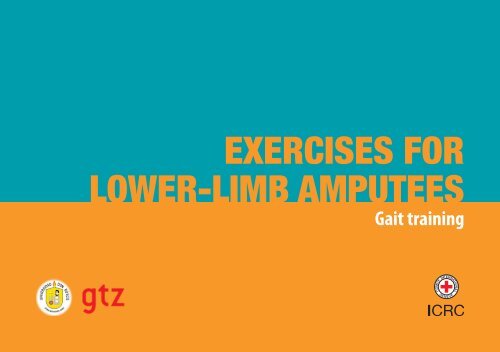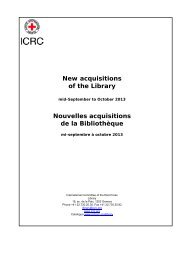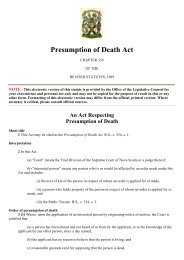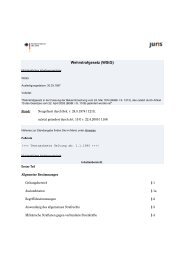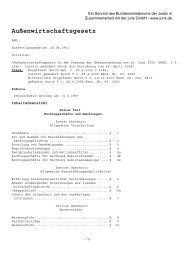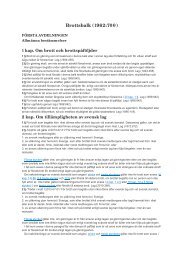Exercises for lower-limb amputees - International Committee of the ...
Exercises for lower-limb amputees - International Committee of the ...
Exercises for lower-limb amputees - International Committee of the ...
You also want an ePaper? Increase the reach of your titles
YUMPU automatically turns print PDFs into web optimized ePapers that Google loves.
exercises <strong>for</strong><br />
<strong>lower</strong>-<strong>limb</strong> <strong>amputees</strong><br />
Gait training
<strong>International</strong> <strong>Committee</strong> <strong>of</strong> <strong>the</strong> Red Cross<br />
19, avenue de la Paix<br />
1202 Geneva, Switzerland<br />
T + 41 22 734 60 01 F + 41 22 733 20 57<br />
E-mail: shop@icrc.org<br />
www.icrc.org<br />
© ICRC, September 2008
Table <strong>of</strong> contents<br />
Introduction 4<br />
1. Weight bearing and balance 7<br />
1.1 Partial weight bearing (two-hand support) 8<br />
1.2 Partial weight bearing (one-hand support) 9<br />
1.3 Partial weight bearing (fingertip support) 10<br />
1.4 Partial weight bearing (without support) 11<br />
1.5 Partial weight shift (two-hand support) 12<br />
1.6 Partial weight shift (one-hand support) 13<br />
1.7 Partial weight shift (without support) 14<br />
1.8 Partial weight shift (two-hand support) 15<br />
1.9 Partial weight shift (one-hand support) 16<br />
1.10 Partial weight shift (without support) 17<br />
1.11 Pelvic rotation 18<br />
1.12 Sideward walking (two-hand support) 19<br />
1.13 Full weight shift (two-hand support) 20<br />
1.14 Full weight shift (without support) 21<br />
1.15 Heel strike (with or without support) 22<br />
1.16 Handball (with or without support) 23<br />
1.17 Balance board 24<br />
1.18 Obstacle stepping (with or without support) 25<br />
1.19 Football (with or without support) 26<br />
1.20 Handball 27<br />
Notes 28<br />
1
2<br />
2. Specific gait training 31<br />
2.1 Sound-leg step <strong>for</strong>ward (two-hand support) 32<br />
2.2 Sound-leg step backward (two-hand support) 33<br />
2.3 Sound-leg step through (two-hand support) 34<br />
2.4 Sound-leg step through (one-hand support) 35<br />
2.5 Sound-leg step through (without support) 36<br />
2.6 Pros<strong>the</strong>tic-leg step <strong>for</strong>ward (two-hand support) 37<br />
2.7 Pros<strong>the</strong>tic-leg step backward (two-hand support) 38<br />
2.8 Pros<strong>the</strong>tic-leg step through (two-hand support) 39<br />
2.9 Pros<strong>the</strong>tic-leg step <strong>for</strong>ward (one-hand support) 40<br />
2.10 Pros<strong>the</strong>tic-leg step through (without support) 41<br />
2.11 Walking between <strong>the</strong> parallel bars (one-hand support) 42<br />
2.12 Walking between <strong>the</strong> parallel bars (without support) 43<br />
Notes 44<br />
3. Advanced exercises 47<br />
3.1 Bouncing a ball (stationary position) 48<br />
3.2 Bouncing a ball (walking) 49<br />
3.3 Balancing a stick 50<br />
3.4 Balancing on <strong>the</strong> pros<strong>the</strong>sis 51<br />
3.5 Walking on an uneven surface 52<br />
3.6 Going up and down a slope 53<br />
3.7 Jumping (<strong>for</strong> below-knee <strong>amputees</strong> only) 54<br />
3.8 Running 55<br />
Notes 56
4. Functional exercises 59<br />
4.1 Rising from a chair 60<br />
4.2 C<strong>limb</strong>ing a staircase 61<br />
4.3.1 Descending a staircase: sound leg step to (<strong>for</strong> above-knee <strong>amputees</strong>) 62<br />
4.3.2 Descending a staircase: sound leg step through (<strong>for</strong> below-knee <strong>amputees</strong>) 63<br />
4.4.1 Sitting down and getting up from <strong>the</strong> floor (method 1: <strong>for</strong>ward) 64<br />
4.4.2 Sitting down and getting up from <strong>the</strong> floor (method 2: backward) 65<br />
4.5 Sitting down on a chair (<strong>for</strong> bilateral <strong>amputees</strong>) 66<br />
4.6 Lying down (<strong>for</strong> bilateral <strong>amputees</strong>) 67<br />
4.7 Getting up from <strong>the</strong> floor (<strong>for</strong> bilateral <strong>amputees</strong>) 68<br />
4.8 Weight carrying 69<br />
Notes 70<br />
Credits 72<br />
The team 72<br />
Bibliography 72<br />
3
4<br />
Introduction<br />
Physio<strong>the</strong>rapy plays a crucial role in <strong>the</strong> post-pros<strong>the</strong>tic<br />
management <strong>of</strong> <strong>lower</strong>-<strong>limb</strong> <strong>amputees</strong>. However,<br />
experience shows that it is neglected or not even available<br />
in many physical-rehabilitation centres that receive<br />
assistance from <strong>the</strong> ICRC and o<strong>the</strong>r aid organizations.<br />
This CD-ROM/booklet seeks to address <strong>the</strong> problem by<br />
providing examples <strong>of</strong> basic post-pros<strong>the</strong>tic exercises<br />
<strong>for</strong> use by physio<strong>the</strong>rapists, physio<strong>the</strong>rapy assistants,<br />
orthopros<strong>the</strong>tists and o<strong>the</strong>rs involved in <strong>the</strong> gait training<br />
<strong>of</strong> <strong>lower</strong>-<strong>limb</strong> <strong>amputees</strong>.<br />
Pros<strong>the</strong>tic gait training has several goals: to help <strong>amputees</strong><br />
adapt to <strong>the</strong>ir new condition, to achieve optimal weight<br />
bearing on <strong>the</strong> pros<strong>the</strong>sis, to improve balance and reaction<br />
to disturbance, to restore <strong>the</strong> optimal gait pattern, to<br />
reduce <strong>the</strong> amount <strong>of</strong> energy needed to walk (transfemoral<br />
<strong>amputees</strong> use up to 50% more energy than<br />
non-<strong>amputees</strong>) and to teach <strong>amputees</strong> how to per<strong>for</strong>m<br />
daily operations like sitting down and walking up and<br />
down stairs. All this will help <strong>amputees</strong> regain <strong>the</strong>ir selfconfidence<br />
and play an active role in society.<br />
It is important that <strong>the</strong> exercises be built up gradually<br />
to reduce <strong>the</strong> risk <strong>of</strong> skin abrasions and consequent<br />
delays in <strong>the</strong> fitting process. A progressive, step-by-step<br />
approach will also minimize gait defects, which hamper<br />
cosmetic and functional restoration.<br />
In administering <strong>the</strong> exercises, daily hands-on, individual<br />
sessions are recommended in addition to group sessions.<br />
It is also advisable to work closely with technical<br />
pros<strong>the</strong>tics personnel with a view to jointly assessing <strong>the</strong><br />
patient’s progress and analysing <strong>the</strong> causes <strong>of</strong> observed<br />
gait defects, preferably on a daily basis.
The exercises are described in four chapters:<br />
1. Weight-bearing and balance exercises<br />
2. Specific gait-training exercises<br />
3. Advanced exercises<br />
4. Functional exercises<br />
In view <strong>of</strong> <strong>the</strong> above, patients should be discouraged<br />
from walking by <strong>the</strong>mselves as soon as <strong>the</strong>y have been<br />
fitted with pros<strong>the</strong>ses, however eager <strong>the</strong>y may be to do<br />
so. Instead, <strong>the</strong>y should follow an exercise programme<br />
allowing <strong>the</strong>m to improve <strong>the</strong>ir abilities gradually.<br />
This booklet presents <strong>the</strong> basic aspects <strong>of</strong> gait<br />
training, taking into account <strong>the</strong> constraints<br />
<strong>of</strong>ten posed by lack <strong>of</strong> qualified personnel<br />
in situations where aid organizations work.<br />
Your comments and/or suggestions are most<br />
welcome and can be addressed to:<br />
ICRC Physical Rehabilitation Programmes<br />
19, avenue de la Paix<br />
1202 Geneva<br />
Switzerland<br />
Tel: + 41 22 734 6001<br />
E-mail: icrc.gva@icrc.org<br />
5
Weight bearing<br />
and balance
1<br />
Weight bearing and balance<br />
It is important to ensure<br />
that <strong>the</strong> patient per<strong>for</strong>ms<br />
<strong>the</strong> exercises accurately,<br />
always maintaining <strong>the</strong><br />
correct posture.
8<br />
1.1 Partial weight bearing (two-hand support)<br />
Step 1 Step 2<br />
Stand between <strong>the</strong> parallel<br />
bars using both hands to<br />
support yourself.<br />
Shift <strong>the</strong> body weight from <strong>the</strong> sound<br />
leg to <strong>the</strong> pros<strong>the</strong>sis (a pair <strong>of</strong> scales<br />
may be useful to measure <strong>the</strong> weight<br />
shifted).
1.2 Partial weight bearing (one-hand support) 1<br />
Stand between <strong>the</strong> parallel<br />
bars using one hand to<br />
support yourself.<br />
Step 1 Step 2<br />
Shift <strong>the</strong> body weight from <strong>the</strong><br />
sound leg to <strong>the</strong> pros<strong>the</strong>sis.<br />
Always use <strong>the</strong> contralateral hand.<br />
CHAPTER<br />
9
10<br />
1.3 Partial weight bearing (fingertip support)<br />
Stand between <strong>the</strong><br />
parallel bars using only<br />
your fingertips to support<br />
yourself.<br />
Step 1 Step 2<br />
Shift <strong>the</strong> body weight from <strong>the</strong><br />
sound leg to <strong>the</strong> pros<strong>the</strong>sis (a<br />
pair <strong>of</strong> scales may be useful to<br />
measure <strong>the</strong> weight shifted).
1.4 Partial weight bearing (without support) 1<br />
Stand between <strong>the</strong> parallel<br />
bars without support.<br />
Step 1 Step 2<br />
Shift <strong>the</strong> body weight<br />
from <strong>the</strong> sound leg to <strong>the</strong><br />
pros<strong>the</strong>sis.<br />
CHAPTER<br />
11
12<br />
1.5 Partial weight shift (two-hand support)<br />
Step 1 Step 2<br />
Stand between <strong>the</strong> parallel<br />
bars using both hands to<br />
support yourself.<br />
Shift <strong>the</strong> pelvis from right<br />
to left and vice versa,<br />
without moving your<br />
shoulders.
1.6 Partial weight shift (one-hand support) 1<br />
Stand between <strong>the</strong> parallel<br />
bars using one hand to<br />
support yourself.<br />
Step 1 Step 2<br />
Shift <strong>the</strong> pelvis from right to<br />
left and vice versa. Always<br />
use <strong>the</strong> contralateral hand.<br />
CHAPTER<br />
13
14<br />
1.7 Partial weight shift (without support)<br />
Stand between <strong>the</strong><br />
parallel bars without<br />
support.<br />
Step 1 Step 2<br />
Shift <strong>the</strong> pelvis from right<br />
to left and vice versa,<br />
without moving your<br />
shoulders.
1.8 Partial weight shift (two-hand support) 1<br />
Step 1 Step 2<br />
Stand between <strong>the</strong> parallel bars<br />
on both legs using both hands to<br />
support yourself.<br />
Shift <strong>the</strong> pelvis <strong>for</strong>ward and<br />
backward, without moving your<br />
shoulders.<br />
CHAPTER<br />
15
16<br />
1.9 Partial weight shift (one-hand support)<br />
Step 1 Step 2<br />
Stand between <strong>the</strong> parallel bars<br />
on both legs using one hand to<br />
support yourself.<br />
Shift <strong>the</strong> pelvis <strong>for</strong>ward<br />
and backward. Always use<br />
contralateral hand.
1.10 Partial weight shift (without support) 1<br />
Step 1 Step 2<br />
Stand between <strong>the</strong> parallel bars<br />
on both legs without support.<br />
Shift <strong>the</strong> pelvis <strong>for</strong>ward and<br />
backward.<br />
CHAPTER<br />
17
18<br />
1.11 Pelvic rotation<br />
Step 1 Step 2<br />
Stand between <strong>the</strong> parallel<br />
bars with or without support.<br />
Rotate <strong>the</strong> pelvis.
1.12 Sideward walking (two-hand support) 1<br />
Step 1 Step 2<br />
Stand between <strong>the</strong> parallel bars<br />
using both hands to support<br />
yourself.<br />
Walk sideways towards <strong>the</strong><br />
pros<strong>the</strong>tic side and back.<br />
CHAPTER<br />
19
20<br />
1.13 Full weight shift (two-hand support)<br />
Step 1 Step 2<br />
Stand between <strong>the</strong> parallel<br />
bars with one leg in front<br />
<strong>of</strong> <strong>the</strong> o<strong>the</strong>r using both<br />
hands to support yourself.<br />
Shift <strong>the</strong> body weight from<br />
one leg to <strong>the</strong> o<strong>the</strong>r by moving<br />
<strong>the</strong> pelvis and trunk from front<br />
to back, with or without <strong>the</strong><br />
support <strong>of</strong> your arms.<br />
Step 3<br />
Repeat <strong>the</strong> exercise,<br />
changing <strong>the</strong> initial<br />
position <strong>of</strong> your legs.
1.14 Full weight shift (without support) 1<br />
Step 1 Step 2<br />
Stand between <strong>the</strong> parallel<br />
bars without support and<br />
with one leg in front <strong>of</strong> <strong>the</strong><br />
o<strong>the</strong>r.<br />
Shift <strong>the</strong> body weight<br />
from one leg to <strong>the</strong> o<strong>the</strong>r<br />
by moving <strong>the</strong> pelvis and<br />
trunk from front to back,<br />
with or without <strong>the</strong> support<br />
<strong>of</strong> your arms.<br />
Step 3<br />
Repeat <strong>the</strong> exercise,<br />
changing <strong>the</strong> initial<br />
position <strong>of</strong> your legs.<br />
CHAPTER<br />
21
22<br />
1.15 Heel strike (with or without support)<br />
Step 1 Step 2<br />
Stand between <strong>the</strong><br />
parallel bars with or<br />
without <strong>the</strong> support <strong>of</strong><br />
your hands.<br />
Step <strong>for</strong>ward with <strong>the</strong><br />
pros<strong>the</strong>sis.<br />
Step 3<br />
Keep <strong>the</strong> knee joint<br />
straight and push <strong>the</strong><br />
heel downwards.
1.16 Handball (with or without support) 1<br />
Step 1 Step 2<br />
Stand between <strong>the</strong> parallel bars<br />
with or without support; place<br />
<strong>the</strong> sound leg on a raised object.<br />
Play catch with <strong>the</strong> instructor.<br />
CHAPTER<br />
23
24<br />
1.17 Balance board<br />
Step 1 Step 2<br />
Stand between <strong>the</strong><br />
parallel bars on a<br />
balance board using<br />
both hands to support<br />
yourself.<br />
Shift <strong>the</strong> body weight<br />
from one leg to <strong>the</strong> o<strong>the</strong>r.<br />
Step 3<br />
Repeat <strong>the</strong> exercise, shifting<br />
<strong>the</strong> body weight from front to<br />
back.
1.18 Obstacle stepping (with or without support) 1<br />
Step 1 Step 2<br />
Stand between <strong>the</strong> parallel bars<br />
with or without support.<br />
Step over an object with <strong>the</strong><br />
sound leg.<br />
CHAPTER<br />
25
26<br />
1.19 Football (with or without support)<br />
Step 1 Step 2<br />
Stand between <strong>the</strong> parallel bars<br />
with or without support.<br />
Kick a ball with <strong>the</strong> sound leg.
1.20 Handball 1<br />
Step 1 Step 2<br />
Stand on both legs between <strong>the</strong><br />
parallel bars.<br />
Play catch with <strong>the</strong> instructor.<br />
CHAPTER<br />
27
28<br />
Notes
Notes 1<br />
CHAPTER<br />
29
Specific<br />
gait training
2<br />
Specific gait training<br />
It is important to ensure<br />
that <strong>the</strong> patient per<strong>for</strong>ms<br />
<strong>the</strong> exercises accurately,<br />
always maintaining <strong>the</strong><br />
correct posture.
32<br />
2.1 Sound-leg step <strong>for</strong>ward (two-hand support)<br />
Step 1 Step 2<br />
Stand between <strong>the</strong> parallel bars<br />
using both hands to support<br />
yourself.<br />
Step <strong>for</strong>ward with <strong>the</strong> sound leg,<br />
keeping hands parallel to <strong>the</strong><br />
pros<strong>the</strong>sis.
2.2 Sound-leg step backward (two-hand support) 2<br />
Step 1 Step 2<br />
Stand between <strong>the</strong> parallel bars<br />
using both hands to support<br />
yourself.<br />
Step backward with <strong>the</strong> sound<br />
leg, keeping hands parallel to<br />
<strong>the</strong> pros<strong>the</strong>sis.<br />
CHAPTER<br />
33
34<br />
2.3 Sound-leg step through (two-hand support)<br />
Step 1 Step 2<br />
Stand between <strong>the</strong> parallel bars<br />
using both hands to support<br />
yourself.<br />
Step <strong>for</strong>ward and backward with <strong>the</strong><br />
sound leg, keeping hands parallel to <strong>the</strong><br />
pros<strong>the</strong>sis. Hold <strong>the</strong> pros<strong>the</strong>sis slightly in<br />
adduction. Maintain an upright position,<br />
allowing <strong>the</strong> trunk and shoulders to<br />
move backward and <strong>for</strong>ward, but without<br />
later<strong>of</strong>lexion.
2.4 Sound-leg step through (one-hand support) 2<br />
Step 1 Step 2<br />
Stand between <strong>the</strong> parallel bars<br />
with support <strong>of</strong> one hand.<br />
Step <strong>for</strong>ward and backward with<br />
<strong>the</strong> sound leg. Always use <strong>the</strong><br />
contralateral hand.<br />
CHAPTER<br />
35
36<br />
2.5 Sound-leg step through (without support)<br />
Step 1 Step 2<br />
Stand between <strong>the</strong> parallel bars<br />
without support.<br />
Step <strong>for</strong>ward and backward with <strong>the</strong><br />
sound leg, holding <strong>the</strong> pros<strong>the</strong>sis<br />
slightly in adduction. Maintain an<br />
upright position, allowing <strong>the</strong> trunk<br />
and shoulders to move backward and<br />
<strong>for</strong>ward, but without later<strong>of</strong>lexion.
2.6 Pros<strong>the</strong>tic-leg step <strong>for</strong>ward (two-hand support) 2<br />
Step 1 Step 2<br />
Stand between <strong>the</strong> parallel bars<br />
using both hands to support<br />
yourself.<br />
Step <strong>for</strong>ward with <strong>the</strong> pros<strong>the</strong>sis,<br />
keeping hands parallel to <strong>the</strong><br />
sound leg.<br />
CHAPTER<br />
37
38<br />
2.7 Pros<strong>the</strong>tic-leg step backward (two-hand support)<br />
Step 1 Step 2<br />
Stand between <strong>the</strong> parallel bars<br />
using both hands to support<br />
yourself.<br />
Step backward with <strong>the</strong> pros<strong>the</strong>sis,<br />
keeping hands parallel to <strong>the</strong><br />
sound leg.
2.8 Pros<strong>the</strong>tic-leg step through (two-hand support) 2<br />
Step 1 Step 2<br />
Stand between <strong>the</strong> parallel bars<br />
using both hands to support<br />
yourself.<br />
Step <strong>for</strong>ward and backward with <strong>the</strong><br />
pros<strong>the</strong>sis, keeping hands parallel to <strong>the</strong><br />
sound leg and holding <strong>the</strong> pros<strong>the</strong>sis<br />
slightly in adduction. Maintain an upright<br />
position, allowing <strong>the</strong> trunk and shoulders<br />
to move backward and <strong>for</strong>ward, but<br />
without later<strong>of</strong>lexion.<br />
CHAPTER<br />
39
40<br />
2.9 Pros<strong>the</strong>tic-leg step <strong>for</strong>ward (one-hand support)<br />
Step 1 Step 2<br />
Stand between <strong>the</strong> parallel<br />
bars using one hand to support<br />
yourself.<br />
Step <strong>for</strong>ward and backward with<br />
<strong>the</strong> pros<strong>the</strong>sis. Always use <strong>the</strong><br />
contralateral hand.
2.10 Pros<strong>the</strong>tic-leg step through (without support) 2<br />
Step 1 Step 2<br />
Stand between <strong>the</strong> parallel bars<br />
without support.<br />
Step <strong>for</strong>ward and backward with<br />
<strong>the</strong> pros<strong>the</strong>sis.<br />
CHAPTER<br />
41
42<br />
2.11 Walking between <strong>the</strong> parallel bars (one-hand support)<br />
Step 1 Step 2<br />
Stand between <strong>the</strong> parallel bars.<br />
Walk between <strong>the</strong>m using<br />
one hand to support yourself.<br />
Always use contralateral hand.<br />
No later<strong>of</strong>lexion <strong>of</strong> <strong>the</strong> trunk or<br />
uneven step length.
2.12 Walking between <strong>the</strong> parallel bars (without support) 2<br />
Step 1 Step 2<br />
Stand between <strong>the</strong> parallel bars.<br />
Walk between <strong>the</strong>m without<br />
support. No later<strong>of</strong>lexion <strong>of</strong> <strong>the</strong><br />
trunk or uneven step length.<br />
CHAPTER<br />
43
44<br />
Notes
Notes<br />
CHAPTER<br />
2<br />
45
AdvAnced<br />
exercises
3<br />
advanced exerciSeS<br />
It is important to ensure<br />
that <strong>the</strong> patient per<strong>for</strong>ms<br />
<strong>the</strong> exercises accurately,<br />
always maintaining <strong>the</strong><br />
correct posture.
48<br />
3.1 Bouncing a ball (stationary position)<br />
Step 1 Step 2<br />
Stand in balance on both legs.<br />
Bounce a ball on <strong>the</strong> ground.
3.2 Bouncing a ball (walking) 3<br />
Step 1 Step 2<br />
Walk while bouncing a ball on <strong>the</strong> ground.<br />
CHAPTER<br />
49
50<br />
3.3 Balancing a stick<br />
Step 1 Step 2<br />
Stand a stick upright on your<br />
hand.<br />
Try to balance it.
3.4 Balancing on <strong>the</strong> pros<strong>the</strong>sis 3<br />
Step 1 Step 2<br />
Stand in balance on <strong>the</strong> pros<strong>the</strong>sis; flex <strong>the</strong> sound leg, trying to keep your balance.<br />
CHAPTER<br />
51
52<br />
3.5 Walking on an uneven surface<br />
Step 1 Step 2<br />
Walk on an uneven surface, keeping to a narrow path.
3.6 Going up and down a slope 3<br />
Go up or down a slope.<br />
Step 1 Step 2<br />
Place <strong>the</strong> body weight on <strong>the</strong><br />
pros<strong>the</strong>sis while doing this.<br />
CHAPTER<br />
53
54<br />
3.7 Jumping (<strong>for</strong> below-knee <strong>amputees</strong> only)<br />
Step 1 Step 2<br />
Jump from a spread-leg position to a closed-leg position and back again.
3.8 Running 3<br />
Step 1 Step 2<br />
Place <strong>the</strong> <strong>for</strong>efoot <strong>of</strong> <strong>the</strong> pros<strong>the</strong>sis on <strong>the</strong> ground and stretch <strong>the</strong> knee, keeping <strong>the</strong> trunk slightly flexed.<br />
CHAPTER<br />
55
56<br />
Notes
Notes<br />
CHAPTER<br />
3<br />
57
functional<br />
exercises
4<br />
functional exerciSeS<br />
It is important to ensure<br />
that <strong>the</strong> patient per<strong>for</strong>ms<br />
<strong>the</strong> exercises accurately,<br />
always maintaining <strong>the</strong><br />
correct posture.
60<br />
4.1 Rising from a chair<br />
Step 1 Step 2<br />
Place <strong>the</strong> sound leg under <strong>the</strong><br />
chair and flex <strong>the</strong> trunk.<br />
Stand up.
4.2 C<strong>limb</strong>ing a staircase 4<br />
Step 1 Step 2<br />
C<strong>limb</strong> a staircase, starting with<br />
<strong>the</strong> sound leg.<br />
Follow with <strong>the</strong> pros<strong>the</strong>sis.<br />
CHAPTER<br />
61
62<br />
4.3.1 Descending a staircase: sound leg step through<br />
(<strong>for</strong> above-knee <strong>amputees</strong>)<br />
Step 1 Step 2<br />
Descend a staircase, starting<br />
with <strong>the</strong> pros<strong>the</strong>sis.<br />
Follow with <strong>the</strong> sound leg,<br />
which comes to rest next to <strong>the</strong><br />
pros<strong>the</strong>sis.
4.3.2 Descending a staircase: sound leg step through<br />
(<strong>for</strong> below-knee <strong>amputees</strong>) 4<br />
Step 1 Step 2<br />
Descend a staircase, placing <strong>the</strong><br />
heel <strong>of</strong> <strong>the</strong> pros<strong>the</strong>sis on <strong>the</strong><br />
edge <strong>of</strong> <strong>the</strong> first step down.<br />
Step through onto <strong>the</strong> next step<br />
with <strong>the</strong> sound leg which comes<br />
to rest next to <strong>the</strong> pros<strong>the</strong>sis .<br />
CHAPTER<br />
63
64<br />
4.4.1 Sitting down and getting up from <strong>the</strong> floor<br />
(method 1: <strong>for</strong>ward)<br />
Step 1 Step 2<br />
Place <strong>the</strong> pros<strong>the</strong>sis in<br />
retr<strong>of</strong>lexion, abduction and<br />
external rotation.<br />
Bend <strong>the</strong> trunk and support<br />
yourself on both hands and one<br />
knee; turn and sit down. Do <strong>the</strong><br />
reverse <strong>for</strong> getting up.
4.4.2 Sitting down and getting up from <strong>the</strong> floor<br />
(method 2: backward) 4<br />
Step 1 Step 2<br />
Move <strong>the</strong> pros<strong>the</strong>sis <strong>for</strong>ward.<br />
Bend <strong>the</strong> knee and support<br />
yourself on both hands; sit<br />
down. Do <strong>the</strong> reverse <strong>for</strong> getting<br />
up.<br />
CHAPTER<br />
65
66<br />
4.5 Sitting down on a chair (<strong>for</strong> bilateral <strong>amputees</strong>)<br />
Step 1 Step 2<br />
Face <strong>the</strong> chair and place one<br />
hand on <strong>the</strong> seat <strong>of</strong> <strong>the</strong> chair and<br />
<strong>the</strong> o<strong>the</strong>r on <strong>the</strong> back.<br />
Turn your body and flex your<br />
legs.<br />
Step 3<br />
Sit down and do <strong>the</strong> reverse <strong>for</strong><br />
getting up.
4.6 Lying down (<strong>for</strong> bilateral <strong>amputees</strong>) 4<br />
Step 2<br />
Increase <strong>the</strong> distance between hands<br />
and feet.<br />
Step 1<br />
Place both hands on <strong>the</strong> floor.<br />
Step 3<br />
Turn around, sit down and lie down<br />
using <strong>the</strong> elbow.<br />
CHAPTER<br />
67
68<br />
4.7 Getting up from <strong>the</strong> floor (<strong>for</strong> bilateral <strong>amputees</strong>)<br />
Step 1 Step 2<br />
Come to a sitting position; turn around<br />
and support yourself on your hands<br />
and knees.<br />
Stretch one pros<strong>the</strong>sis backward and<br />
outward; shift <strong>the</strong> body weight to <strong>the</strong><br />
stretched pros<strong>the</strong>sis and both arms;<br />
stretch <strong>the</strong> o<strong>the</strong>r pros<strong>the</strong>sis; decrease <strong>the</strong><br />
distance between hands and feet and<br />
stand up.
4.8 Weight carrying 4<br />
Step 1 Step 2<br />
Walk carrying a weight on <strong>the</strong> pros<strong>the</strong>tic side.<br />
CHAPTER<br />
69
70<br />
Notes
Notes 4<br />
CHAPTER<br />
71
72<br />
Credits<br />
This CD ROM/booklet is based on an internal ICRC document produced in 1990 by Theo Verhoeff.<br />
The team: <strong>International</strong> <strong>Committee</strong> <strong>of</strong> <strong>the</strong> Red Cross (ICRC)<br />
Theo Verhoeff, PT, MPH<br />
Barbara Rau, PT, MPTSc<br />
François Friedel, PT<br />
Deutsche Gesellschaft für Technische Zusammenarbeit (GTZ)<br />
Heinz Trebbin, Project Manager<br />
University Don Bosco, El Salvador<br />
Gilberto Meléndez, Designer and Animator<br />
Hector Rodríguez, Animator<br />
Bibliography: Engstrom B., Van de Ven C.<br />
Therapy <strong>for</strong> Amputees, Churchill Livingstone, London, 1999
MISSION<br />
The <strong>International</strong> <strong>Committee</strong> <strong>of</strong> <strong>the</strong> Red Cross (ICRC) is an impartial, neutral and<br />
independent organization whose exclusively humanitarian mission is to protect <strong>the</strong><br />
lives and dignity <strong>of</strong> victims <strong>of</strong> armed conflict and o<strong>the</strong>r situations <strong>of</strong> violence and to<br />
provide <strong>the</strong>m with assistance.<br />
The ICRC also endeavours to prevent suffering by promoting and streng<strong>the</strong>ning<br />
humanitarian law and universal humanitarian principles.<br />
Established in 1863, <strong>the</strong> ICRC is at <strong>the</strong> origin <strong>of</strong> <strong>the</strong> Geneva Conventions and <strong>the</strong><br />
<strong>International</strong> Red Cross and Red Crescent Movement. It directs and coordinates <strong>the</strong><br />
international activities conducted by <strong>the</strong> Movement in armed conflicts and o<strong>the</strong>r<br />
situations <strong>of</strong> violence.
For fur<strong>the</strong>r in<strong>for</strong>mation, visit<br />
www.icrc.org<br />
<strong>International</strong> <strong>Committee</strong> <strong>of</strong> <strong>the</strong> Red Cross<br />
19, avenue de la Paix<br />
1202 Geneva, Switzerland<br />
T + 41 22 734 60 01 F + 41 22 733 20 57<br />
E-mail: shop@icrc.org<br />
www.icrc.org<br />
© ICRC, September 2008<br />
0936/002 09.2008 300


